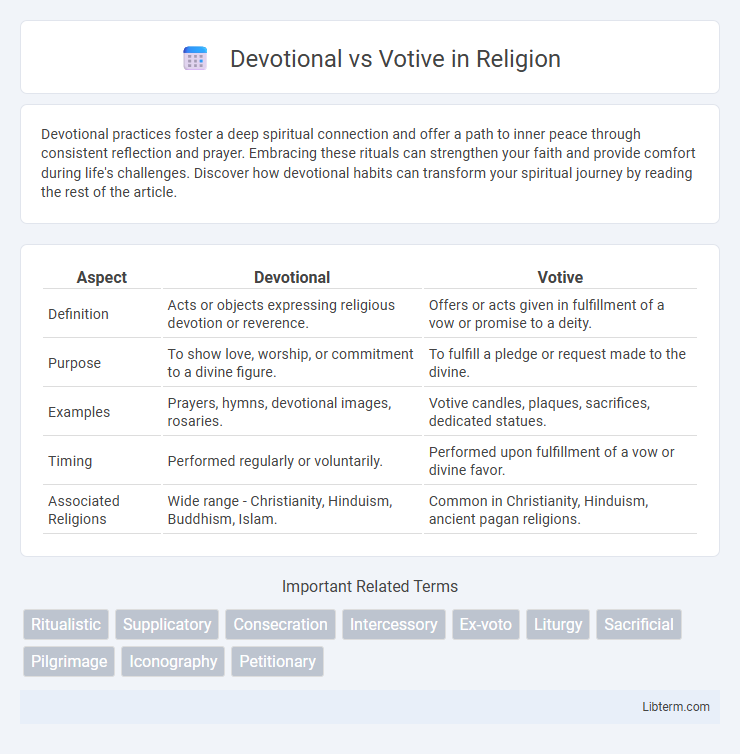Devotional practices foster a deep spiritual connection and offer a path to inner peace through consistent reflection and prayer. Embracing these rituals can strengthen your faith and provide comfort during life's challenges. Discover how devotional habits can transform your spiritual journey by reading the rest of the article.
Table of Comparison
| Aspect | Devotional | Votive |
|---|---|---|
| Definition | Acts or objects expressing religious devotion or reverence. | Offers or acts given in fulfillment of a vow or promise to a deity. |
| Purpose | To show love, worship, or commitment to a divine figure. | To fulfill a pledge or request made to the divine. |
| Examples | Prayers, hymns, devotional images, rosaries. | Votive candles, plaques, sacrifices, dedicated statues. |
| Timing | Performed regularly or voluntarily. | Performed upon fulfillment of a vow or divine favor. |
| Associated Religions | Wide range - Christianity, Hinduism, Buddhism, Islam. | Common in Christianity, Hinduism, ancient pagan religions. |
Understanding Devotional and Votive Practices
Devotional practices center on acts of worship and personal piety, reflecting an individual's dedication to a deity or spiritual figure through prayers, rituals, and offerings. Votive practices involve specific pledges or vows made to express gratitude or seek divine favor, often manifested through the offering of votive objects such as candles, plaques, or statues. Both devotional and votive actions play significant roles in religious traditions by deepening faith, fostering spiritual connection, and symbolizing commitment.
Defining Devotional Offerings
Devotional offerings are acts or objects presented as expressions of religious dedication, reflecting personal faith and reverence without expecting specific favors in return. These offerings often include prayers, hymns, or symbolic items intended to honor deities or saints in a spiritual context. Unlike votive offerings, which are given to fulfill a vow or in gratitude for a specific answered prayer, devotional offerings emphasize ongoing worship and devotion.
What Are Votive Offerings?
Votive offerings are objects or gifts presented in fulfillment of a vow or in gratitude for divine favor, commonly found in religious or spiritual contexts. These offerings often include candles, plaques, statues, or small tokens left at shrines, churches, or temples as expressions of devotion or petitions for blessings. Unlike general devotional acts, votive offerings specifically symbolize a commitment or thanksgiving tied to a personal or communal spiritual promise.
Historical Origins of Devotional Acts
Devotional acts trace back to ancient religious practices rooted in expressing piety, faith, and reverence toward divine figures or saints, often through rituals, prayers, and offerings. Historically, these acts emerged as personal or communal expressions of devotion aimed at fostering spiritual connection and seeking blessings, predating the more specialized votive offerings. Votives, by contrast, originated as specific thank offerings or requests for divine intervention, typically physical objects dedicated in sanctuaries or shrines.
The Evolution of Votive Traditions
Votive traditions have evolved from simple offerings to complex ritualistic practices within religious contexts, deeply rooted in expressions of devotion and gratitude. Historically, votive objects such as candles, plaques, or figurines served as tangible symbols of prayers or fulfilled vows, reflecting the spiritual relationship between worshippers and deities. This evolution highlights the transition from personal devotional acts to communal and cultural ceremonies, enriching the religious landscape with meaningful, material representations of faith.
Spiritual Significance of Devotional Items
Devotional items hold profound spiritual significance as they serve as tangible expressions of faith and personal commitment in religious practice. These objects, ranging from rosaries to prayer cards, facilitate deeper connection with the divine and enhance meditative focus during worship. Unlike votive offerings, which are specific acts of gratitude or requests for divine intervention, devotional items consistently support ongoing spiritual discipline and reflection.
Purpose and Intent Behind Votive Gifts
Votive gifts serve as tangible expressions of gratitude, devotion, or requests for divine intervention, often left at sacred sites or altars to symbolize a vow or fulfilled promise. Unlike devotional items, which primarily support personal spiritual practices and worship, votive offerings carry a specific intent to seek blessings or give thanks in response to answered prayers. The purpose behind votive gifts centers on creating a physical acknowledgment of faith and petition, reinforcing the reciprocal relationship between worshippers and the divine.
Devotional vs Votive: Key Differences
Devotional items are objects or practices used to express personal faith and spiritual devotion, such as prayer beads or icons, intended for ongoing religious engagement. Votive offerings, by contrast, are gifts or symbolic acts made in fulfillment of a vow or in gratitude, often left at shrines or altars as a tangible sign of a request or thanks granted. The key difference between devotional and votive lies in their purpose: devotional relates to sustained worship and spiritual discipline, while votive specifically pertains to a promise or thanksgiving fulfilled through a physical or ritual offering.
Cultural Examples of Devotional and Votive Practices
Devotional practices often involve personal or communal acts of worship such as prayer, meditation, or pilgrimage, exemplified by Catholic rosary prayers and Hindu puja ceremonies. Votive practices typically include offerings or objects given in fulfillment of a vow, seen in the ancient Roman tradition of dedicating votive statues and the Japanese ema plaques where wishes are inscribed and hung at Shinto shrines. Both types of practices underscore the cultural significance of expressing faith and gratitude through tangible rituals across diverse religious contexts.
Contemporary Relevance of Devotional and Votive Offerings
Devotional offerings express personal faith and spiritual connection, often seen in contemporary practices such as prayer beads, candles, and sacred art, which foster a sense of community and devotion. Votive offerings, traditionally given in fulfillment of a vow or in gratitude, remain relevant as symbolic gestures in modern religious and secular contexts, including charitable donations and ritual objects. Both forms continue to evolve, reflecting cultural values and sustaining religious heritage in today's diverse spiritual landscape.
Devotional Infographic

 libterm.com
libterm.com